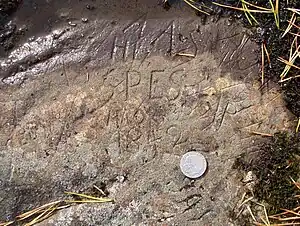Fäbodristning
Fäbodristningar or vallgångsristningar are carvings on trees and mountains with text, symbols, runes, figures, initials and other signs, that have been found in Sweden in connection with the herding of animals in the 17th century and forward, mainly left by youths who worked with the herding.[1][2]

Photographer placed a 1 krona coin for comparison in size.
Origins
In Dalarna, Sweden, a few hundred carvings have been found,[1] most of them in the Ore area (in Rättvik Municipality) of Dalarna.[3] The carvings were made with a knife and often followed the same pattern of initials, year, and often information about them, importantly the first or last day of the fäbod (summer pasture) period.[2]
The carvings are mostly concentrated in certain locations and areas such as hills and close to the water as they were good places for herding in the north of Sweden.[1][2] One of these places are Hästbergs klack north of Ludvika.[4] At times, a review of the herding period such as "Good" or "Bad" were found. On one tree branch in Ore, Dalarna, three girls who herded left a carving saying "We feel good as hell". It was customary that women made carvings on trees, while men made them on stones.[1][4]
See also
References
- Fakta Scog: Vi har tre kor borta – gamla träd som historiska arkiv(in Swedish) Archived October 16, 2013, at the Wayback Machine
- DT.se: Fler fäbodristningar funna (in Swedish)
- Allan Stenbomsgaten: Fotoalbum (in Swedish)
- Visf.com: Den gamla fäbodristningen Archived 2013-10-16 at the Wayback Machine (in Swedish)